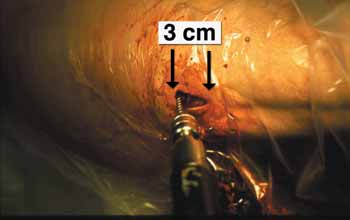Screws were effective in minimally invasive hip surgery
‘Safe zone’ allowed for incision between trochanter and artery.
![]() Hip
screws implanted percutaneously significantly reduced operating times and blood
loss while producing outcomes comparable to the conventional technique.
Hip
screws implanted percutaneously significantly reduced operating times and blood
loss while producing outcomes comparable to the conventional technique.
The yearlong prospective, randomized trial at McGill University included 21 patients in the minimally invasive group and 27 patients in the conventional group, all of whom received the same hip screw system, the Synthes DHS.
Results showed that operating time in the percutaneous group was less than half that of the conventional group (29 min. vs. 70 min., P<.001), and hemoglobin decrease was less for the minimally invasive group (22.3 g/dL vs. 29.3 g/dL, P<.001).
Edward J. Harvey, MD, assistant professor of surgery at McGill, presented the results at the Orthopaedic Trauma Association 19th Annual Meeting in Salt Lake City.
Time and money
|
|
|
Courtesy of Edward J. Harvey |
In a telephone interview with Orthopedics Today, Harvey said the results show that older devices can be used effectively with new surgical techniques, and that the drive to develop new implants also raises the price tag of surgery.
“I think we often lose sight of that when we’re trying to come up with a solution for a problem we don’t have,” Harvey said. He noted that a plate costs less than $200, while a new intramedullary nail might be as much as $2000.
Along with the greater expense of new implants comes new procedures that require time to learn before they can be used effectively.
“Recently, when you bring any new device in … you have a new system, a new inventory, and it’s an education process for all the hospital OR staff,” Harvey said.
Using a conventional screw system inserted percutaneously offers the benefits of shorter operation times and less blood loss, Harvey said. He also noted that older devices, unlike new implants, might already have a history of clinical tests supporting their use.
In his trial, incisions for the percutaneous procedures were made in an area between the ridge of the trochanter and the first significant perforator. An angiogram review showed an average of 9.3 cm between the lower edge of the trochanteric flare and a 1-mm artery below it.
Safe zone
Investigators dubbed that area the “safe zone,” and made a 3-cm incision in that area for each minimally invasive procedure. Harvey said surgeons stayed within the safe zone every time.
Patients in the minimally invasive group also showed less postoperative pain and took fewer days to reach walker ambulation, though the differences were not statistically significant.
Fixation failure did not occur in either group of patients.
For more information:
- Harvey EJ, al-Obaid A, Elder G, et al. Minimally invasive dynamic hip screw: randomized comparison to conventional technique. #19. Presented at the Orthopaedic Trauma Association 19th Annual Meeting. Oct. 9-11, 2003. Salt Lake City.

